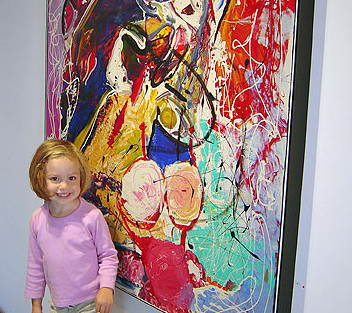My Kid Could Paint That, and so could I
20 July 2008 3 Comments
Last week I watched a 2007 documentary titled My Kid Could Paint That. It chronicles the rise and fall of four year old painter Marla Olmstead.
Watching the film was an academic exercise for me. However, it was also enjoyable. I took notes on a number of things as I watched. The most interesting part of the film, though, is easy to recall, and that is how the adults and the art world reacted to the four year old’s paintings. Even the documentary notes that this story isn’t about the little girl; it’s about the adults.
“Marla and Darlene’s Buterfly [sic] Bikini II”
I’ll start with a little background. Dad was painting one day and daughter, Marla, wanted to join in (she wasn’t even two years old at this point). She took to painting like a fish to water. After a while, a friend of the family sees the girl’s paintings and wants to put them in his coffee shop — just for kicks as much as anything. Customers began to want the paintings. Marla sold her first work for $250. A local reporter wrote a story about Marla and her family after being encouraged by a local artist who saw the toddler’s canvases. From there it steamrolled. The New York Times picked up the story, and the family began traveling around the world for shows. At one point, the waiting list for Marla’s works was more than 70 people.
Mom didn’t know what to make of the situation early on, rightly concerned for the well-being of her child. “If this never happened again I think that’d be OK,” she said at one point, referring to one of Marla’s first exhibits. Mom is a dental hygienist and admitted that she wouldn’t know if the paintings were extraordinary or not. She photocopied the first check from the first sale for Marla’s scrapbook, thinking the whole ordeal would be short-lived. The reporter who did the first story, Elizabeth Cohen, also worried about the girl after the hype became so much.
Just as fast as the fun began it ended. A 60 Minutes story speculated that the paintings were actually done by the girl’s father. Sales tanked (by this point the family had already made $300,000 on the paintings) and vicious hate mail poured in. Eventually the family was able to film Marla painting a piece titled Ocean from start to finish, which seemed to vindicate the family and the young artist.
Now to some of the artistic implications of the whole scenario. First off, the artist who encouraged Cohen to write the first newspaper story has it in for modern art. He said so on camera. Anthony Brunelli is a hyper-realist who’s paintings can take 9 months to finish. The most Brunelli ever sold a painting for was $100,000, which he admitted was a lot of money, but he’s right in questioning why a four year old can make $15,000 for something she might have spent five distracted hours on.
Something is wrong with this picture, and it’s no fault of the girl, her family, the reporter or the hyper-realist. People like myself, Tim Jones, my friend Joel Armstrong and a myriad of others who’ve spent time and money being educated in the arts struggle to find any buyers for what we produce. In fact, we have to find places to store unsold works. And we’re offering what we’ve poured our hours, finances and talent into at a fraction of the price Marla’s works pull in. Jones recently talked about why he priced one of his best works at a mere $3,000. Believe you me, if the man was selling works quickly enough at that price, he’d begin charging more for his canvases (Correct me if I’m wrong, Tim).
Elizabeth Cohen’s mother, interestingly, hates modern art. She talked to Cohen about how Jackson Pollock’s paintings seemed to say to her, “You’re stupid and I’m not, and there are people smarter than you that get my paintings.” Here we dig back into the artist-as-genius pot. Jackie Wescot, interviewed in the documentary, has independently taught art for 23 years. Wescot collects Marla’s paintings. She also claims that the child has a gift, something that’s very advanced that she can’t explain, like Mozart. She’s not the only one with this opinion. Brunelli, as much as he claimed to have it in for modern art, is quoted on Marla’s website as saying that “When I am in Marla’s presence, there’s a weird feeling ’cause I know there’s something inside this girl that many artists look for their whole lives and never have.” When Marla’s dad approached Wescot about teaching the child in the arts, the teacher refused, suggesting that the toddler had nothing more to learn.
Where in the world did Wescot — and SO many others like her in the art world — get the idea that a four or five year old girl didn’t need training in the arts because she already knew it all? Marla already knows about perspective? She already knows the importance of observation, the proportions of the human figure, the ideal of the Golden Mean?
Wescot has been bamboozled, as have so many other artists and collectors in the past century or so, by this unfounded artist-as-genius mentality. Yes, there is talent. Some people are gifted with the ability to paint and sculpt, others aren’t. Yes, there are different degrees of this ability. But children still need training. The simple fact of the matter is that I could recreate Marla’s paintings while half-asleep if I wanted too. Most any person with a studio art degree could take their fingers and spatulas and make paintings that look like hers if they wanted to.
And so could a lot of other untrained kids. Where’s the genius in that?
One or two of the enamored collectors interviewed in My Kid Could Paint That talk about the “spirituality” in Marla’s artwork. One gentleman goes on about a blue square in the corner of the painting he purchased, and the squiggle on one side that’s a person juxtaposed (hey, there’s another principle the little girl oughta learn about from Wescot) with another squiggly figure and what this all means, or what he thinks the four year old meant by it. That’s getting a bit too Freudian for me.
The gentleman was seeing bunnies in the clouds. I’ve talked numerous times in the past about the associations viewers bring to a canvas. We can see most anything we want to see if we try hard enough, especially in non-representational works (the people in the documentary erroneously use the term “abstract” to describe Marla’s paintings). Our experiences, our desires and our faith — the example this gentleman seemed to lean on — color how we perceive everything. That’s not bad necessarily, but we have to be aware of it when we’re critiquing a work of art. Just because something looks phallic (getting back to Freud?), for instance, does not mean that it is, or that it was intended by the artist to be phallic. This is a pet peeve of mine, people comparing art to genitalia. Residents in my native Nebraska can’t seem to think of the historic and acclaimed capitol building without thinking of a phallus. It’s a tall, well-designed building with a dome on the top, ladies and gents. Please get a grip while I exhale.
The documentary goes on to suggest that Marla’s innocence, her youth, says something about the cynicism of the art world. The appeal of her work may be, one of the interviewees speculates, that her innocence isn’t clouded by said cynicism. Marla’s paintings don’t make snarky remarks about the viewers like, supposedly, a lot of modern art does. This was another interesting point that I noted as I watched the film, but I don’t know where to go with it in this post.
There was a lot to be taken from the film, if you really want to dig into it, and these are just my initial thoughts. It’s worth watching, although I wasn’t all that happy with some of the content editing as it related to an accurate presentation. I’m very curious, in conclusion, to know how the paintings get their titles, something that wasn’t addressed in the documentary.


The painting shown is certainly comparable to some good abstract work I’ve seen in shows here and there, and I have no problem with that. One of the things I think good abstract work has going for it is a sense of play. Whimsy. If she’s just having fun with paint, I don’t see any reason why her work shouldn’t be fun to look at.
The piece is well composed and the color choices work. Nice texture (from what I can tell). If that’s a result of her own innate artistic instincts, then I’d say she may have a good chance at maintaining a career over time. Once it becomes more like work, though…
This brings to mind another young artist known mainly for being precocious. She was on Oprah, and everything;
http://www.artakiane.com/home.htm
I think the best thing for her right now is to be left pretty well alone for several years, so she can have some space to sort out what kind of artist she wants to be. The themes and style that got so much attention as a youngster may not be well suited to carry her forward and mature artistically, I don’t know.
As an addendum; the little girl is just beautiful. I always end up looking at her smile, rather than the painting. Kids are great.
Oh, I didn’t see the second painting when I commented. Guess it loaded more slowly than the other. I don’t think it’s as strong as the one shown at the top of the post. I do like the typical little kid-like rendering of a lady’s head at the bottom right, though, with the Marlo Thomas hair. It’s kind of reassuring… there is a pretty ordinary kindergartener in there, somewhere. Some archetypes are just undeniable.
I didn’t even get into my own opinions of her paintings. By the time I thought about it, the post was already kind of long . . .
I do like the layering, the impasto, and the recurring use of circles in her paintings. You’re right to point out that what’s good and easy as a child may not be what will carry into a career.
I’ve heard of Akiane. My wife and I are both convinced I’ve posted about her before too, but I can’t find it for anything right now . . . Maybe I only dreamt of posting it!